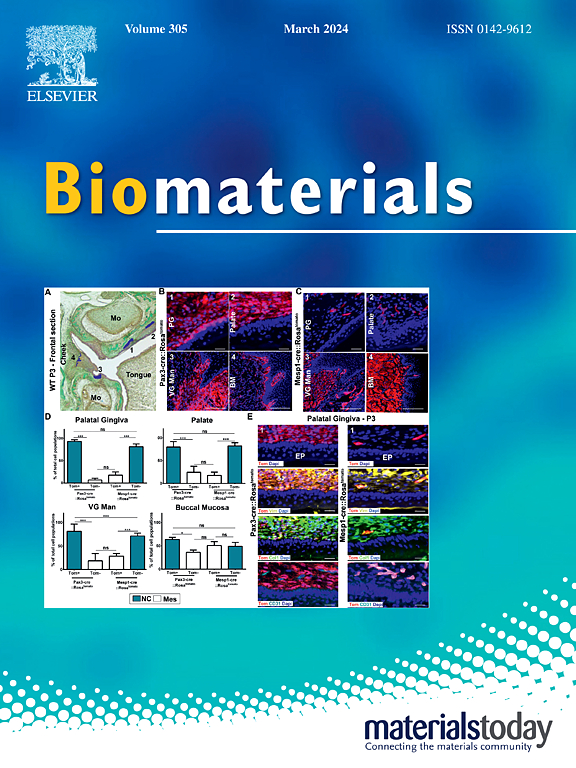Reversible shear stress-mediated mechanoregulation of endothelial cell function in thixotropic hydrogels via L-type Ca2+ channel and focal adhesion molecules for accelerated vascularization
IF 12.8
1区 医学
Q1 ENGINEERING, BIOMEDICAL
引用次数: 0
Abstract
Developing functional vascular networks in engineered tissues is crucial for regenerative medicine. Recently, thixotropic hydrogel has emerged as a promising approach due to their 3D-printability and force-responsive dynamics. However, their gel-sol transitions under physiological loading and subsequent mechanoregulation mechanism on vascularization remains inadequately explored. Here, the reversible shear stress induced in thixotropic hydrogels under bionic cyclic stretching (5 % strain, and 0.5, 1 or 1.5 Hz) has been demonstrated to significantly accelerate endothelial cell adhesion, migration, and angiogenesis. These dynamic mechanical responses are precisely quantified and monitored through computational simulations and specially designed experimental apparatus. Mechanistic investigations reveals that the mechanically regulated cell behavior is mediated by cell adhesion molecules and calcium signaling pathways, which can be inhibited using Talin bloker (e.g., neomycin) and L-type voltage-gated calcium channel antagonists (e.g., verapamil), respectively. Furthermore, subcutaneous implantation of thixotropic hydrogels in rats results in denser and more rapid vascularization compared to non-thixotropic hydrogels. The reversible shear stress-regulated vascularization strategy is anticipated to offer a novel and efficient approach for constructing functional blood vessels in regenerative medicine.
可逆剪切应力介导的触变性水凝胶内皮细胞功能的机械调节,通过l型Ca2+通道和局灶黏附分子加速血管化
在工程组织中建立功能性血管网络对再生医学至关重要。最近,触变性水凝胶由于其3d打印性和力响应动力学而成为一种有前途的方法。然而,它们在生理负荷下的凝胶-溶胶转变以及随后对血管化的机械调节机制仍未得到充分探讨。在仿生循环拉伸(5%应变,0.5、1或1.5 Hz)下,触变性水凝胶中诱导的可逆剪切应力已被证明可以显著加速内皮细胞的粘附、迁移和血管生成。通过计算模拟和专门设计的实验装置,对这些动态力学响应进行了精确的量化和监测。机制研究表明,机械调节的细胞行为是由细胞粘附分子和钙信号通路介导的,它们可以分别被Talin阻断剂(如新霉素)和l型电压门控钙通道拮抗剂(如维拉帕米)所抑制。此外,与非触变性水凝胶相比,大鼠皮下植入触变性水凝胶会导致更密集和更快的血管形成。可逆剪切应力调节血管化策略有望为再生医学中构建功能血管提供一种新颖有效的方法。
本文章由计算机程序翻译,如有差异,请以英文原文为准。
求助全文
约1分钟内获得全文
求助全文
来源期刊

Biomaterials
工程技术-材料科学:生物材料
CiteScore
26.00
自引率
2.90%
发文量
565
审稿时长
46 days
期刊介绍:
Biomaterials is an international journal covering the science and clinical application of biomaterials. A biomaterial is now defined as a substance that has been engineered to take a form which, alone or as part of a complex system, is used to direct, by control of interactions with components of living systems, the course of any therapeutic or diagnostic procedure. It is the aim of the journal to provide a peer-reviewed forum for the publication of original papers and authoritative review and opinion papers dealing with the most important issues facing the use of biomaterials in clinical practice. The scope of the journal covers the wide range of physical, biological and chemical sciences that underpin the design of biomaterials and the clinical disciplines in which they are used. These sciences include polymer synthesis and characterization, drug and gene vector design, the biology of the host response, immunology and toxicology and self assembly at the nanoscale. Clinical applications include the therapies of medical technology and regenerative medicine in all clinical disciplines, and diagnostic systems that reply on innovative contrast and sensing agents. The journal is relevant to areas such as cancer diagnosis and therapy, implantable devices, drug delivery systems, gene vectors, bionanotechnology and tissue engineering.
 求助内容:
求助内容: 应助结果提醒方式:
应助结果提醒方式:


